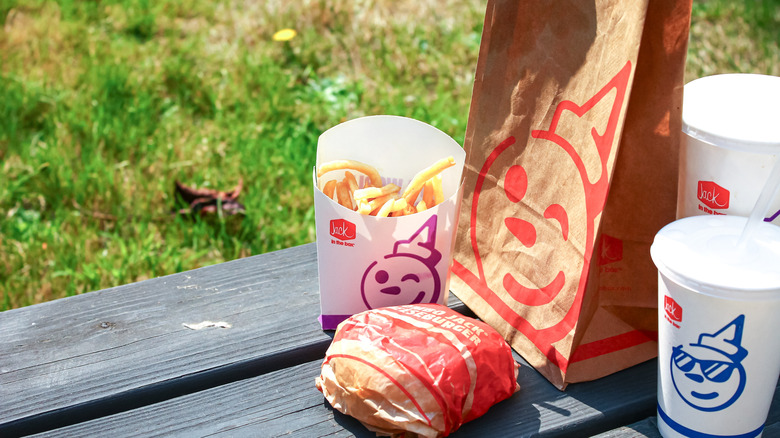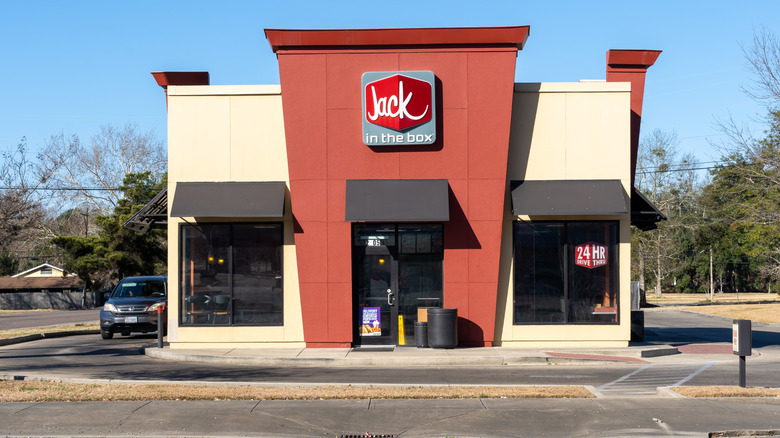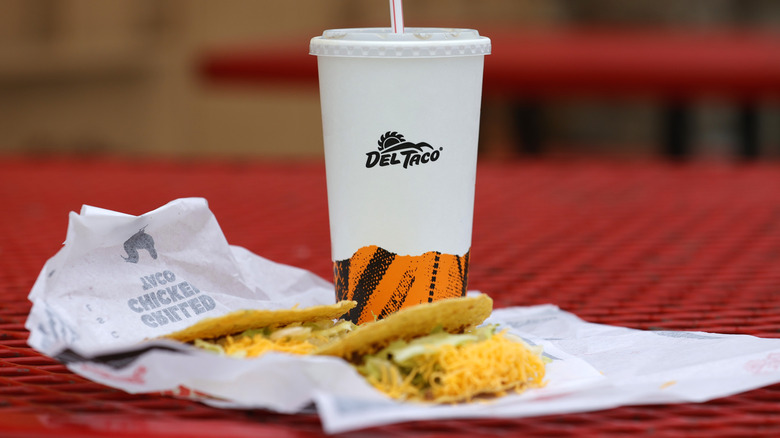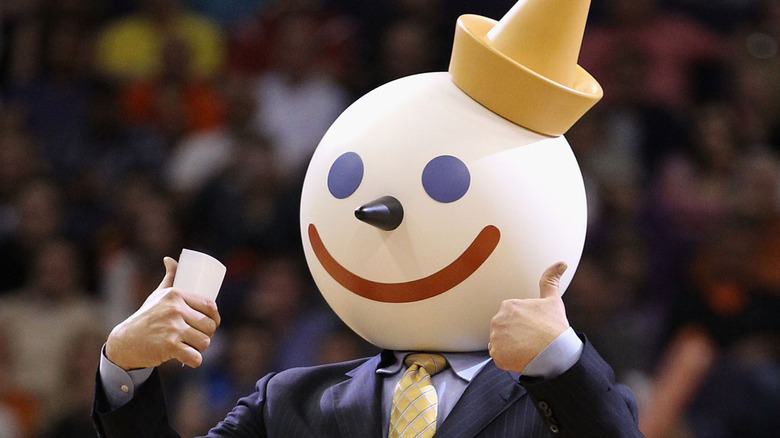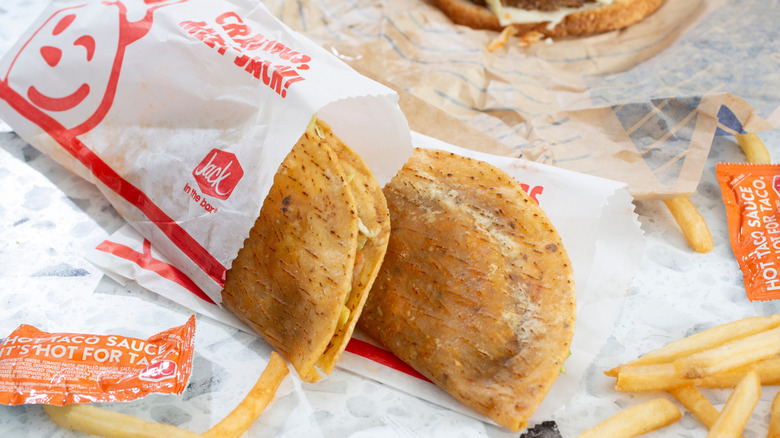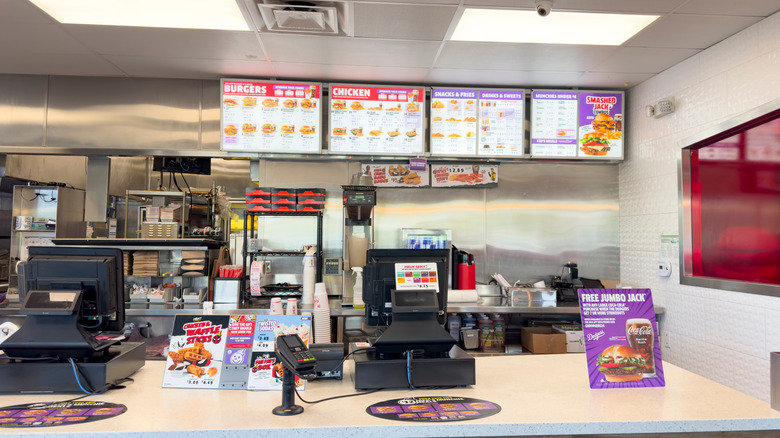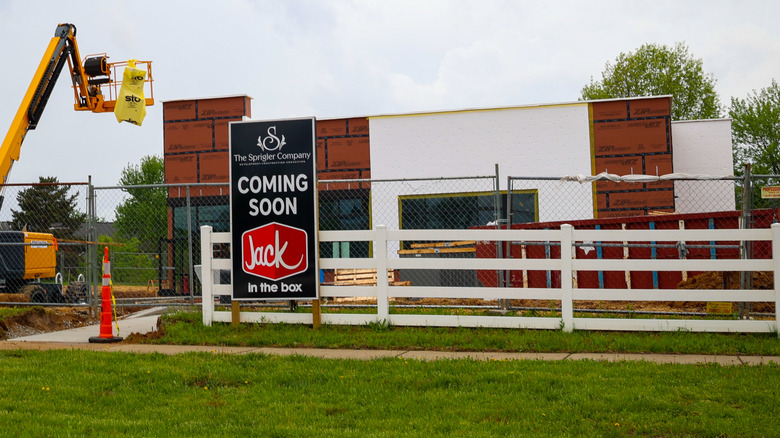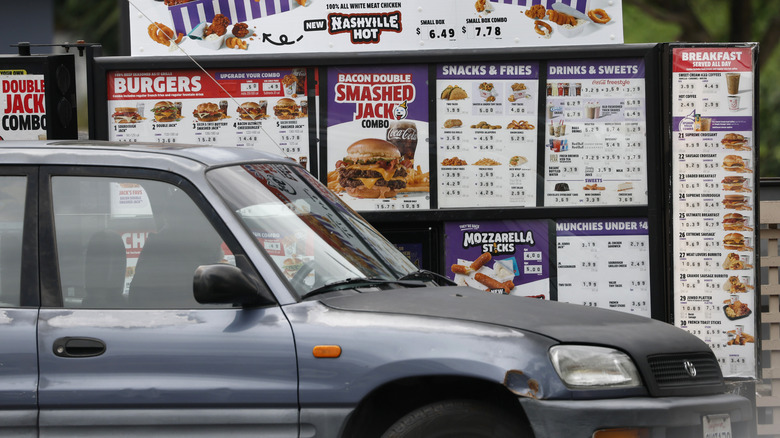Signs Jack In The Box Is Struggling
Jack in the Box has survived in one form or another since the 1950s. While it initially started out as a hamburger stand, it later toyed with the idea of being an upscale and mature chain called Monterey Jack's before finally taking its place among the icons of fast food. How did the company do it? Part of its success comes down to the fact that it has always been willing to try new things. Jack in the Box may sell burgers and fries like McDonald's, Burger King, and Wendy's, but it's also a place where consumers can find very special tacos with a cult following, an array of chicken products, rice bowls, egg rolls, and churros. It's also responsible for some of the most consistently offbeat yet hilarious advertisements in the fast food industry.
There are still thousands of Jack in the Box stores around the U.S. open for business. These restaurants typically operate from breakfast through the late-night — which, coincidentally, seems to be when Jack in the Box comes to life, with the fast food chain doing notably well between 10 p.m. and 4 a.m. Its menu remains consistent, and it still produces a steady stream of entertaining commercials. However, there have been a few signs lately that the chain is struggling. Whether it's moving into a rut or veering towards something more permanent, we're growing concerned about the fast food chain. Here's why the future isn't looking so bright for Jack in the Box.
Jack in the Box is closing hundreds of restaurants
In the first quarter of 2025, Americans spent less money than they had in four years. Rising costs, impending tariffs on international goods, and shaky confidence in the domestic economy inspired millions to cut back on their purchases, with fast food chains feeling the sting and, in turn, closing restaurants. Jack in the Box, which boasts more than 2,000 restaurants, experienced such a speedy loss of business that in April 2025, it announced a plan to quickly shut down somewhere between 150 and 200 locations. The company explained that it would close the restaurants generating the least profits, despite a significant chunk of this lineup being in operation for more than three decades.
While Jack in the Box didn't immediately announce which spots would close down, it did reveal that the plans will affect 80 to 120 restaurants by the end of 2025. The remaining targeted outlets will close on a looser timeline, as per the terms of franchisee contracts. Altogether, about 1% of Jack in the Box's footprint will disappear in order to make conditions more economically agreeable. The company doesn't think the first round of closures will fully fix its problems, either. It aims to reduce its store count by another 1% in 2026 and maintain this annual rate for the foreseeable future.
It's unloading a side business
Mexican-inspired fast food got its start in the United States in Southern California. That's where Taco Bell opened its first store, as did Jack in the Box, which is arguably just as popular for its unique deep-fried tacos as it is for its burgers. The chain has tried on multiple occasions to claim a bigger piece of the Tex-Mex market, and then come to regret it. It bought, expanded, and sold off Qdoba in 2017 after sales dropped abruptly. Just five years later, Jack in the Box Inc. completed its acquisition of the entirety of California-founded Del Taco. The new owners spent $585 million on the fast food company, acquiring around 600 restaurants.
Less than three years later, a beleaguered Jack in the Box is ready to bail on its latest fast food Mexican subsidiary. In fiscal year 2024, sales at Del Taco locations fell by 1.5%. Del Taco also closed its restaurants in Colorado in early 2025. Blaming the desire to pay off $300 million or more of its debt by mid-2026, Jack in the Box declared in April 2025 that it was officially exploring sale options for Del Taco.
Jack in the Box's marketing campaigns appear to be rudderless
A confident company with a solid financial outlook is one with a clear and unified marketing plan. Jack in the Box has seemingly been faltering in this area. As recently as a few years ago, its advertising was humorous with a strong narrative that revolved around Jack Box, the company's eager (and slightly unhinged) CEO, portrayed by an actor wearing a clown headpiece designed to look like Jack in the Box's logo and antenna toppers.
In the last few years, Jack in the Box has moved away from that very entrenched campaign and instead started targeting a new niche audience. The Jack Box character still narrates its ads, but is rarely seen. Jack in the Box advertisements have focused more on food, deals, and bargain boxes. Many of these are somewhat audaciously marketed to marijuana aficionados, stressing that most stores are open late at night and that they sell a variety of Munchie Meals. In 2025, the company gave a nod to the subculture with a line of pineapple-based drinks and desserts sold under the "Pineapple Express" umbrella title, alluding to the stoner comedy of the same name.
Jack in the Box regulars claim that the chain changed the food for the worse
At the end of the day, a fast food chain's fortunes are only as good as its food. Regular Jack in the Box customers have reported growing tired with the chain's offerings and instead moving on to get their burgers, tacos, and chicken sandwiches elsewhere, having been deterred by menu changes and the use of new ingredients.
Jack in the Box customers have flocked online to debate whether the company has quietly changed the shells used in its tacos. "Today I bought 6 tacos and the shells were entirely different," posted one user on Reddit. "Way thicker, less crunchy and bland with burn marks all over them. I called the local restaurant and they agreed the shells looked different." Other Jack in the Box regular customers agreed that something seemed amiss. In the summer of 2024, another Jack in the Box fan noticed a supposed shift in the chain's barbecue sauce. "Today I went and the label on the sauce was different, it was only 3/4 of the way full and WAY sweeter [than] before," they wrote on Reddit. An alleged Jack in the Box employee confirmed that the company had begun serving different barbecue and sweet and sour dipping sauces, much to the chagrin of other customers.
Its prices keep going up
A suite of international economic issues in recent years has manifested in the form of price increases on many consumer goods, including food. The impact is clear at some fast food restaurants. Jack in the Box is one of the many chains affected. According to The Street, items on the fast food giant's menu sustained an average cost increase of 45% between 2019 and 2024.
For customers who are still content with the quality of food at Jack in the Box, pricing is a factor that still pushes them to eat elsewhere. Until a few years ago, the restaurant chain was among the least expensive fast food purveyors. "I would order from Jack to save money and get a quick meal like [every day] a year and a half ago. Now it feels not worth it," one Reddit user wrote. Using the Jack in the Box app offers some discounts, but even those deals seem lackluster to customers. "I used to be able to get a good deal on the 'App only' section or their coupons because there was variety. Now they just force you to spend $10+ in order to get something," alleged another Reddit user.
Jack in the Box had to implement a major improvement protocol
Potentially closing down hundreds of stores and getting rid of Del Taco are just two items in a far-reaching self-preservation plan adopted by Jack in the Box in 2025. Jack in the Box's "Jack on Track" plan was unveiled to shareholders in April 2025. It's a complex series of business and corporate moves that will theoretically reverse Jack in the Box's slide by improving cash flow and reorganizing its real estate portfolio, adding it to the list of restaurant chains making big changes in 2025.
As part of a capital allocation program, Jack in the Box hopes to produce fresh income by selling off properties and then immediately use that money to reduce its accrued debts. The fast food chain will also forgo paying dividends to stockholders for now and instead use those funds to tackle its debts, plus reacquire as many shares as possible. As far as growth is concerned, Jack in the Box will hold off building new restaurants from 2026 and instead take on the less costly move of revamping existing locations.
It's out of date and falling behind the competition
At least Jack in the Box knows it needs to change and is trying to course-correct. The "Jack on Track" agenda directly acknowledges some qualms that customers and fast food industry experts have voiced about the fast food chain. Chick-fil-A, Raising Cane's, and McDonald's are growing despite operating under the same economic conditions, and yet Jack in the Box's numbers are falling or standing still. According to Steven Johnson — known as the Grocerant Guru with consultancy Foodservice Solutions – the issue is that Jack in the Box's operations are similarly not moving forward. Other brands generate interest and business with limited offers and specials, while Jack in the Box's pursuit of the stoner segment operates at the expense of attracting new customers.
Research also suggests that Jack in the Box is lagging in efficiency, which can lead to customer dissatisfaction. Its average wait time in the drive-thru is about five minutes, far longer than that of competitors like McDonald's and Chick-fil-A. Also making a visit to Jack in the Box more clunky and unattractive is its failure to utilize emerging technology. While Jack in the Box has an app, it rates low in customer satisfaction and is subject to glitches.
